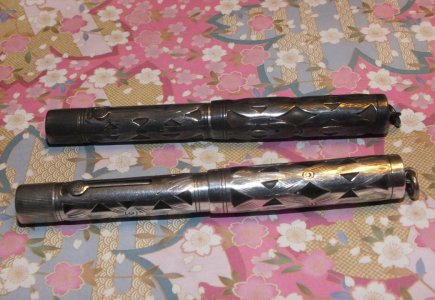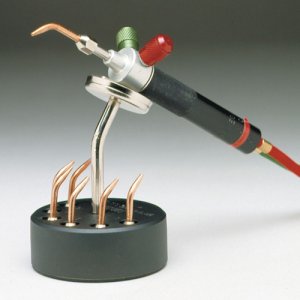- Joined
- Jul 31, 2020
- Messages
- 765
The first questions I would ask are: What is it made of? Silver Plate, Silver Fill, Sterling Silver, Fine Silver.
Silver plate is normally silver over brass. Silver fill is also normally silver over brass. Sterling is normally an alloy of 92.5% silver, with 7.5% copper.
Fine Silver is typically .99 (or better) silver.
First step is always cleaning and inspection. The various jewelry stores sell high quality silver polishing cloths, which restore a wonderful luster. They also place a very fine film on the surface which reduces the rate tarnish re-forms.
That would determine my "treatment of an area which may need silver-soldered/brazed. Ideally the donor material for the solder/braze needs to match the composition of the silver the object is made of, so you don't get a difference in color.
I restore antique fountain pens as a "side-Gig". The picture below shows two examples of the same pen (Waterman 452 Sterling Ringtop). One had a polishing cloth taken to it. The darker one has been left with the natural Patina. For some people, removing patina from antiques is considered a mortal (and unforgivable) sin.
Silver plate is normally silver over brass. Silver fill is also normally silver over brass. Sterling is normally an alloy of 92.5% silver, with 7.5% copper.
Fine Silver is typically .99 (or better) silver.
First step is always cleaning and inspection. The various jewelry stores sell high quality silver polishing cloths, which restore a wonderful luster. They also place a very fine film on the surface which reduces the rate tarnish re-forms.
That would determine my "treatment of an area which may need silver-soldered/brazed. Ideally the donor material for the solder/braze needs to match the composition of the silver the object is made of, so you don't get a difference in color.
I restore antique fountain pens as a "side-Gig". The picture below shows two examples of the same pen (Waterman 452 Sterling Ringtop). One had a polishing cloth taken to it. The darker one has been left with the natural Patina. For some people, removing patina from antiques is considered a mortal (and unforgivable) sin.




